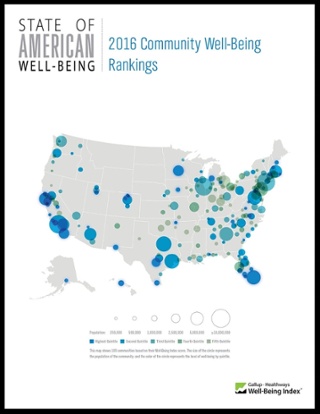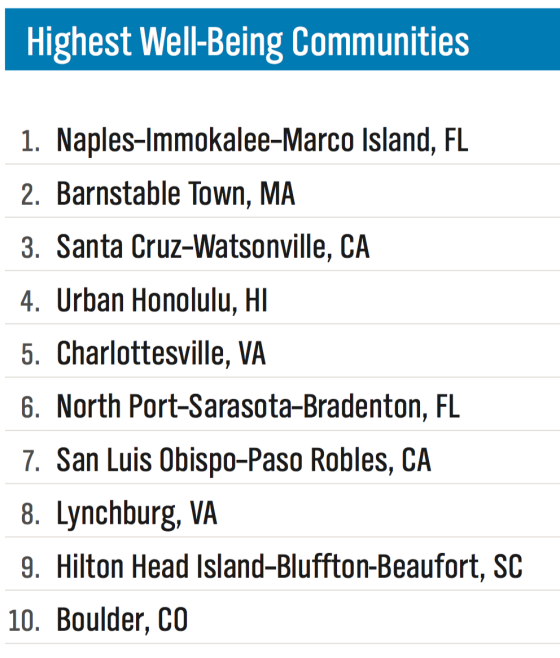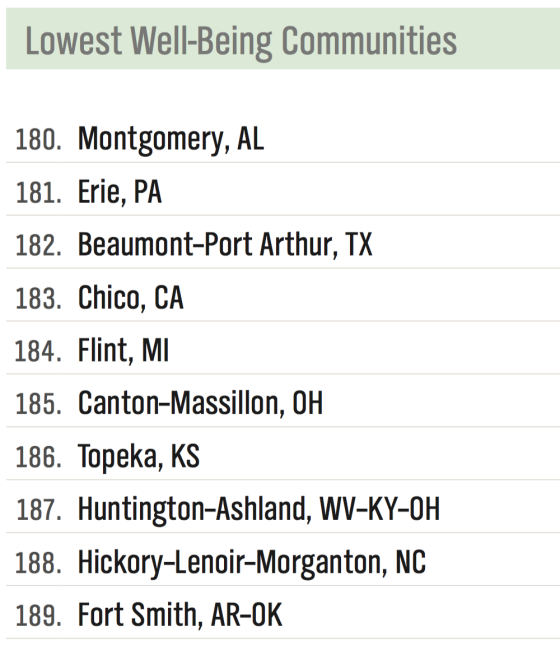 Geography is destiny, Napoleon is thought to have first said. More recently, the brilliant physician Dr. Abraham Verghese has spoken about “geography as destiny” in his speeches, such as “Two Souls Intertwined,” The Tanner Lecture he delivered at the University of Utah in 2012.
Geography is destiny, Napoleon is thought to have first said. More recently, the brilliant physician Dr. Abraham Verghese has spoken about “geography as destiny” in his speeches, such as “Two Souls Intertwined,” The Tanner Lecture he delivered at the University of Utah in 2012.
Geography is destiny for all of us when it comes to our health and well-being, once again proven by Gallup-Healthways in The State of American Well-Being 2016 Community Well-Being Rankings.
The darkest blue circles in the U.S. map indicate the metro areas in the highest-quintile of well-being. The index of well-being is based on five metrics, of consumer self-ranking in terms of what Healthways calls “The Well-Being 5:”
- Purpose, “liking what you do each day and being motivated to achieve your goals;”
- Social, “having supportive relationships and love in your life;”
- Financial, “managing your economic life to reduce stress and increase security;”
- Community, “liking where you live, feeling safe and having pride in your community;” and,
- Physical, “having good health and enough energy to get things done daily.”
The Index is calculated on a scale of 0 to 100, with 0 equal to the lowest possible well-being and 100, the highest possible well-being.

The table lists the top ten well-being communities, beginning with Naples, Florida, MSA. Naples began participating in the Blue Zones Project in 2015, adding more walkability and bike-ability to the town, farmers markets, restaurant and grocery programs, and active transportation options in the community. I have a dear cousin who relocated to Naples from Toronto, Ontario, many years ago, and as highly-ranked as Canada is for national brand equity today in U.S. News & World Report, he would tell you that his quality of life is par excellence across the five dimensions of well-being.
Nationally, the top ten states for well-being according to Gallup-Healthways are:
- Hawaii
- Alaska
- South Dakota
- Maine
- Colorado
- Vermont
- Arizona
- Montana
- Minnesota, and
- Texas.
Gallup’s survey was conducted among over 350,000 U.S. adults from all 50 states and the District of Columbia, surveyed throughout 2016. Overtime, the Index has included over 2.3 million surveys measuring how people feel about their daily lives.
 Health Populi’s Hot Points: Now check out the lowest well-being communities, according to the Gallup-Healthways survey. These communities tend to rank low for health care access (such as health insurance coverage, dental visits in the last 12 months, and healthcare insecurity), chronic conditions (including obesity, depression, and diabetes), and healthy eating and smoking. West Virginia and Kentucky have recorded the lowest well-being status in the U.S. for the past eight years in a row.
Health Populi’s Hot Points: Now check out the lowest well-being communities, according to the Gallup-Healthways survey. These communities tend to rank low for health care access (such as health insurance coverage, dental visits in the last 12 months, and healthcare insecurity), chronic conditions (including obesity, depression, and diabetes), and healthy eating and smoking. West Virginia and Kentucky have recorded the lowest well-being status in the U.S. for the past eight years in a row.
Kentucky has worked to expand healthcare access, and thus healthcare security, through Medicaid expansion as part of the Affordable Care Act. The state’s former governor, Steve Beshear, responded to President Trump’s address last week on this point, featured in this video. Under Governor Beshear, Kentucky’s uninsured rate fell down from 20% to 7.5%, providing healthcare access to about one-half million Kentuckians.
With the fate of the Affordable Care Act and Medicaid expansion in doubt, the financial and physical components of U.S. health citizens’ well-being are at-risk. At this moment, many prominent members of the GOP are unhappy about the proposed Obamacare replacement the American Healthcare Act, which was revealed last night.
Remember that geography is destiny, and that a preponderance of President Trump’s voters are in states that did not expand Medicaid, also falling into the lowest well-being rankings. Health is made with healthcare, but also built on social determinants of health. The President has the opportunity to build on both, if he, Secretary Price of the Department of Health and Human Services, and Secretary Carson of the Department of Housing, can consider baking health into all public policies.




 Thanks to Feedspot for naming this blog, Health Populi, as a
Thanks to Feedspot for naming this blog, Health Populi, as a